Photograph by Ing-On Vibulbhan-Watts
I went to Thailand to visit my family for two months, from July and August 2017. I did not visit home since 2006. I was glad to see my family. I enjoyed seeing all new development in Bangkok and loved eating authentic Thai food, especially Thai fruits.
I had a chance to visit my home town, Lopburi, where I was raised when I was young, before we moved to Bangkok. I traveled to Ayutthaya to see the ruins of temples that were burned by Burmese soldiers, when the Burmese wanted to take over Thailand, The Burmese–Siamese War (1765–1767). Ayutthaya was one of the former capitals of Thailand before moved to, Thonburi and then Bangkok. I also traveled to, Chiang Mai, located in the Northern part of Thailand. Chiang Mai is the second largest and second most popular city of Thailand.
John, my husband came to Thailand in August. He joined me traveling to different part of Thailand. I had a good time taking videos and photographs wherever I traveled around Bangkok and other part of Thailand. I hope the viewers of my website will enjoy the photographs that I present in these projects.
Ing-On Vibulbhan-Watts, Thursday, October 26, 2017
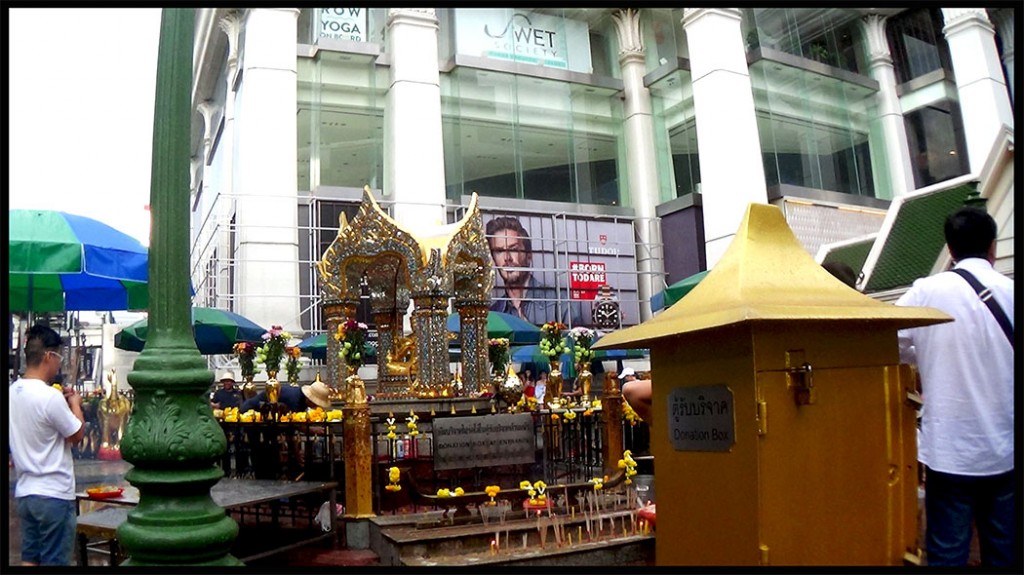
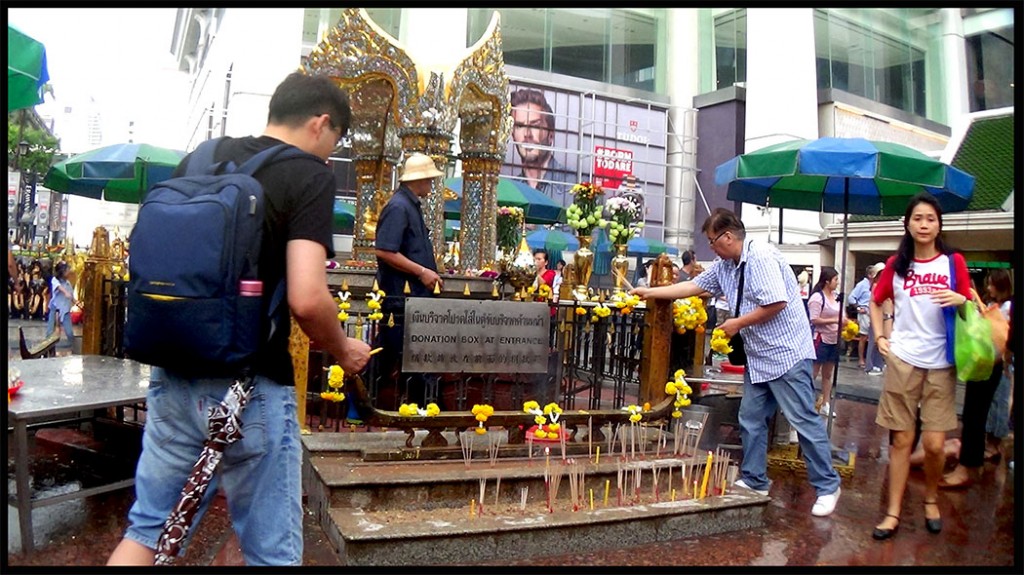 Worshiper at the Erawan Shrine, Bangkok, Thailand
Worshiper at the Erawan Shrine, Bangkok, Thailand
“Erawan Shrine in Bangkok is Brahman, not strictly Buddhist. And yet, this famous shrine attracts more visitors than many of the city’s temples. It was erected during the mid 1950s, after the Thai government had decided to build the luxury Erawan Hotel on this location. However, the first stages of the construction were beset with so many problems that superstitious labourers refused to continue unless the land spirits were appeased. After consultations with astrologers, the erection of a shrine to honour the four-faced Brahma God, Than Tao Mahaprom, was considered to be an auspicious solution. A magnificent image of the Brahma God was especially cast and gilded, and The Erawan Hotel opened to acclaims and worldwide fame for three decades. Towards the end, the property could not compete with more modern facilities, and was replaced by the privately owned Grand Hyatt Erawan Bangkok in 1991. As the shrine was originally constructed to grace the old Erawan Hotel, the location became known as the Erawan Shrine.”
For more information please visit the following link:
https://www.bangkok.com/shrines/erawan-shrine.htm#
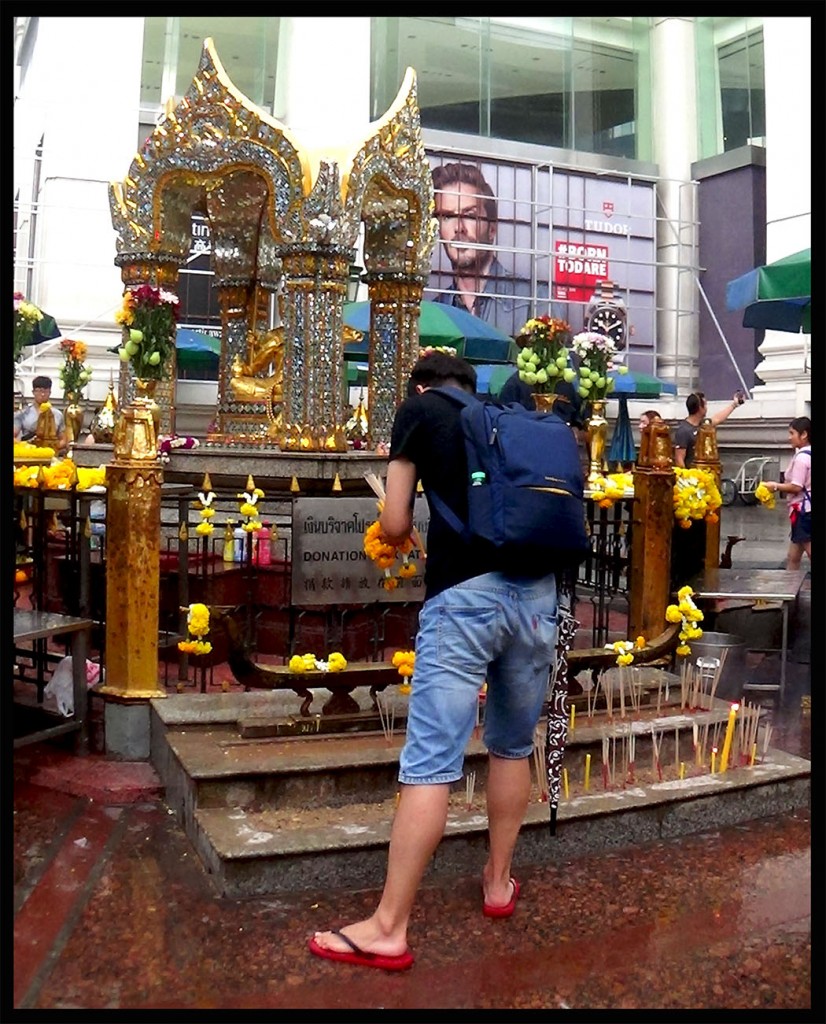
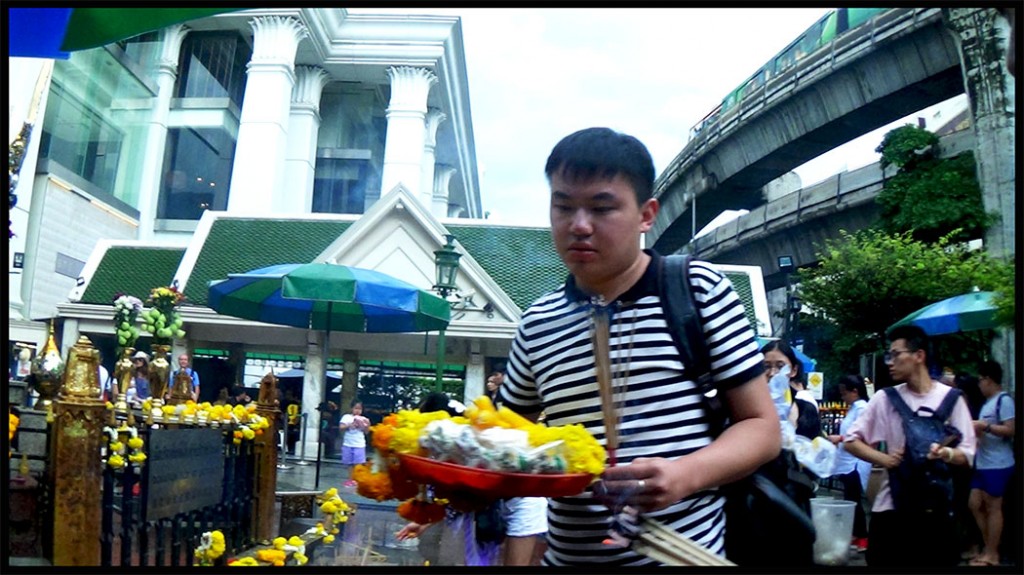
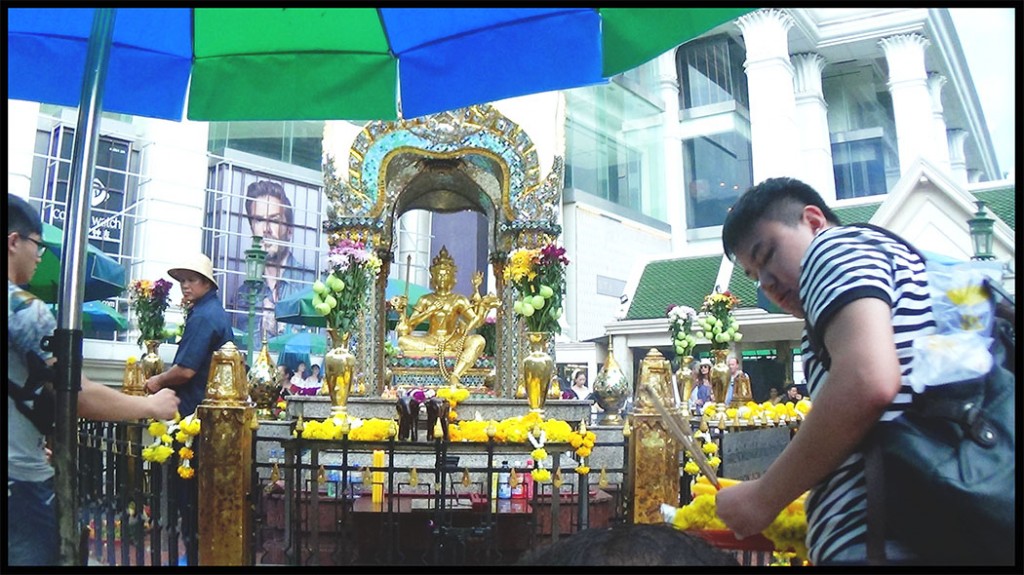 Phra Phrom (The four-faced Brahma God) at the Erawan Shrine, Bangkok, Thailand
Phra Phrom (The four-faced Brahma God) at the Erawan Shrine, Bangkok, Thailand
“Worshippers of the god usually offer incense, candles, jasmine flowers or jasmine garlands and young coconut milk (with water in them) in their worship, usually placing these offerings before all four heads of Phra Phrom, each head representing a different aspect of the deity; it is believed each side of Phra Phrom offers different blessings. Another common way of worship is to place wooden elephant statues on the altar to honor him. Phra Phrom is also known to admire Thai classical music, which is played near larger scale outdoor altars, accompanied by dancers. For a small fee, the dancers include worshiper’s name into the songs they sing while dancing. Worshipers of Phra Phrom are also usually advised to abstain from consuming meat. It is also believed that worshipers have to make good on any promises made to the deity else misfortune will befall them instead of the fortune that was asked for. Items needed for prayers are available in the premises of the shrine.”
For more information please visit the following link:
https://en.wikipedia.org/wiki/Phra_Phrom
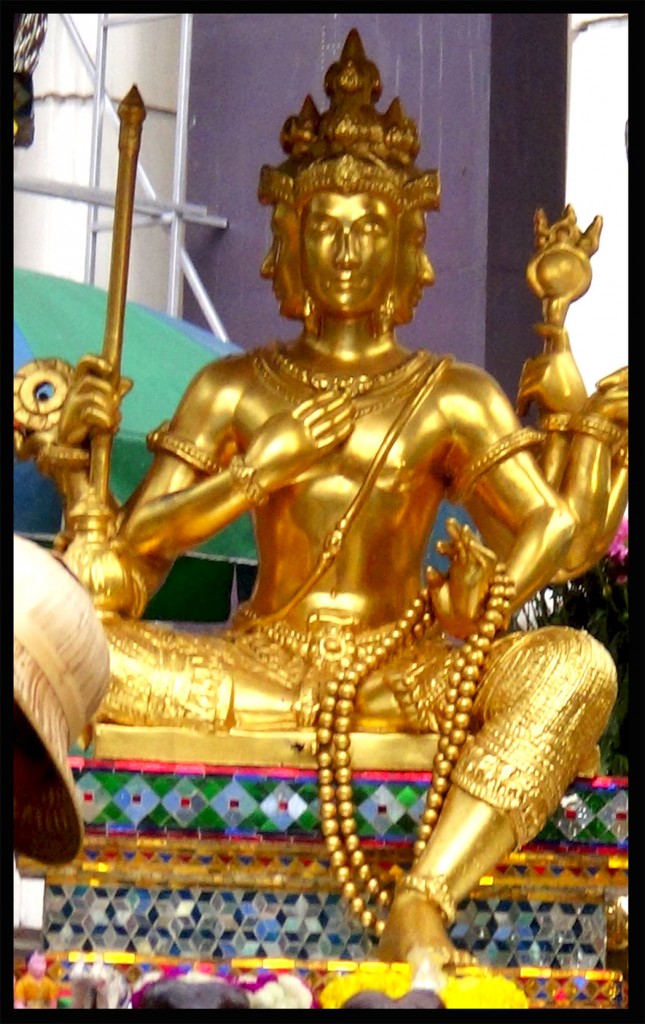 Phra Phrom (The four-faced Brahma God) at the Erawan Shrine, Bangkok, Thailand
Phra Phrom (The four-faced Brahma God) at the Erawan Shrine, Bangkok, Thailand
“Phra Phrom (Thai: ???????; from Sanskrit:Brahma, ??????) is the Thai representation of the Hindu god Brahma (the god of the manifested world),[1] who is regarded in Thai culture as a deity of good fortune and protection. According to puranas, Brahma has four faces representing four Vedas or knowledge coming from four directions: north, south, east and west[2]. Phra Phrom is colloquially known outside Thailand as the Four-Faced Awakening (???, Sìmiànfó) or Four-Faced God (??? Simianshen). Among Chinese folk religious worshipers, among whom the faith of this god has spread in the latest decades by assimilating Brahma as Buddist deva Brahma.”
For more information please visit the following link:
https://en.wikipedia.org/wiki/Phra_Phrom

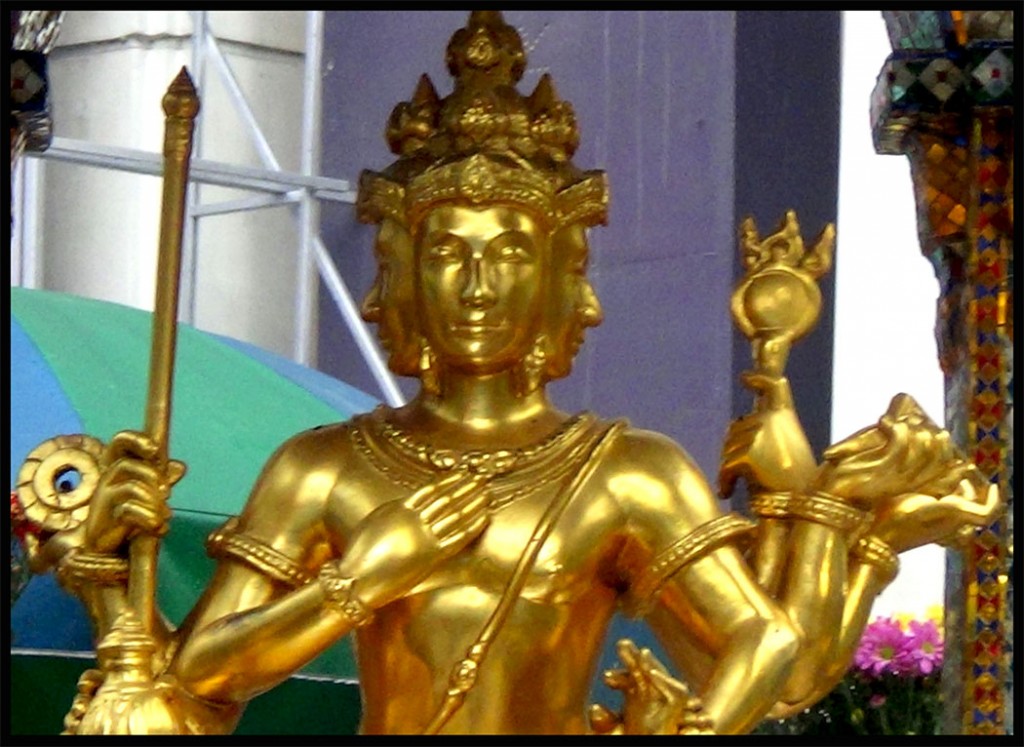 Phra Phrom (The four-faced Brahma God) at the Erawan Shrine, Bangkok, Thailand
Phra Phrom (The four-faced Brahma God) at the Erawan Shrine, Bangkok, Thailand
“Spread of the cult among Chinese
As early as the 1980s, the popularity of the Erawan cult of Brahma from its inceptions in Thailand spread, accompanied by faithful reproduction of the structure of the shrine and the image, among overseas Chinese in other countries of Southeast Asia (Singapore, Indonesia and Malaysia), in Taiwan, and in China, with shrines established in Hong Kong, Shanghai and Guangzhou. Chinese call Brahma colloquially the “Four-Faced Buddha” (??? Simianfo).”
For more information please visit the following link:
https://en.wikipedia.org/wiki/Phra_Phrom
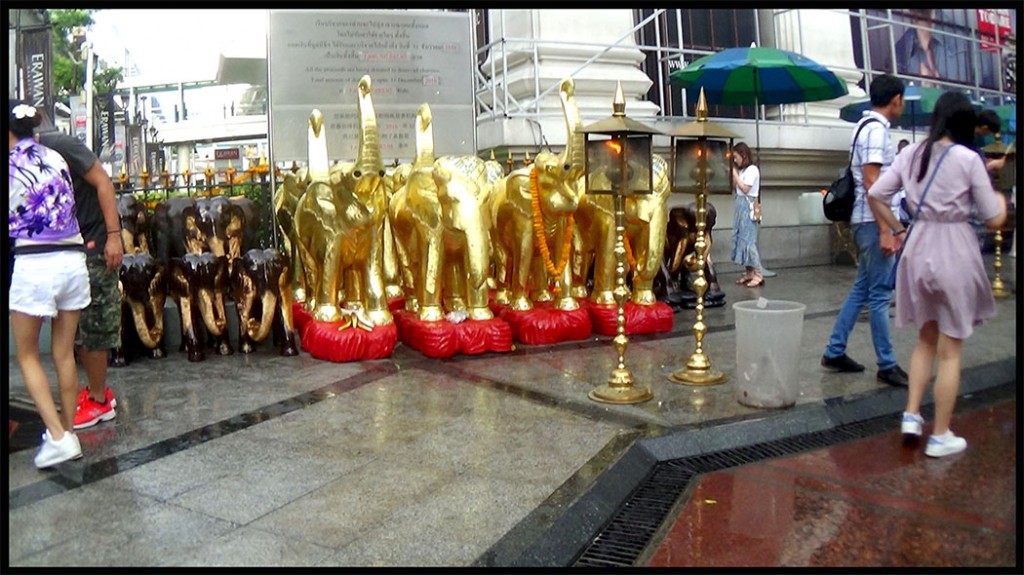 Elephant Statues used as adornment at the Worship of Phra Phrom (the four-faced Brahma God) at the Erawan Shrine, Bangkok, Thailand
Elephant Statues used as adornment at the Worship of Phra Phrom (the four-faced Brahma God) at the Erawan Shrine, Bangkok, Thailand
Photograph by Ing-On Vibulbhan-Watts
“Cultural depictions of elephants
Elephants have been depicted in mythology, symbolism and popular culture. They are both revered in religion and respected for their prowess in war. They also have negative connotations such as being a symbol for an unnecessary burden. Ever since the stone age, when elephants were represented by ancient petroglyphs and cave art, they have been portrayed in various forms of art, including pictures, sculptures, music, film, and even architecture.”
For more information please visit the following link:
https://en.wikipedia.org/wiki/Cultural_depictions_of_elephants
Elephant Statues used as adornment at the Worship of Phra Phrom (the four-faced Brahma God) at the Erawan Shrine, Bangkok, Thailand
“The Asian elephant appears in various religious traditions and mythologies. They are treated positively and are sometimes revered as deities, often symbolising strength and wisdom. Similarly, the African elephant is seen as the wise chief who impartially settles disputes among the forest creatures in African fables,[2] and the Ashanti tradition holds that they are human chiefs from the past.[3]”
For more information please visit the following link:
https://en.wikipedia.org/wiki/Cultural_depictions_of_elephants
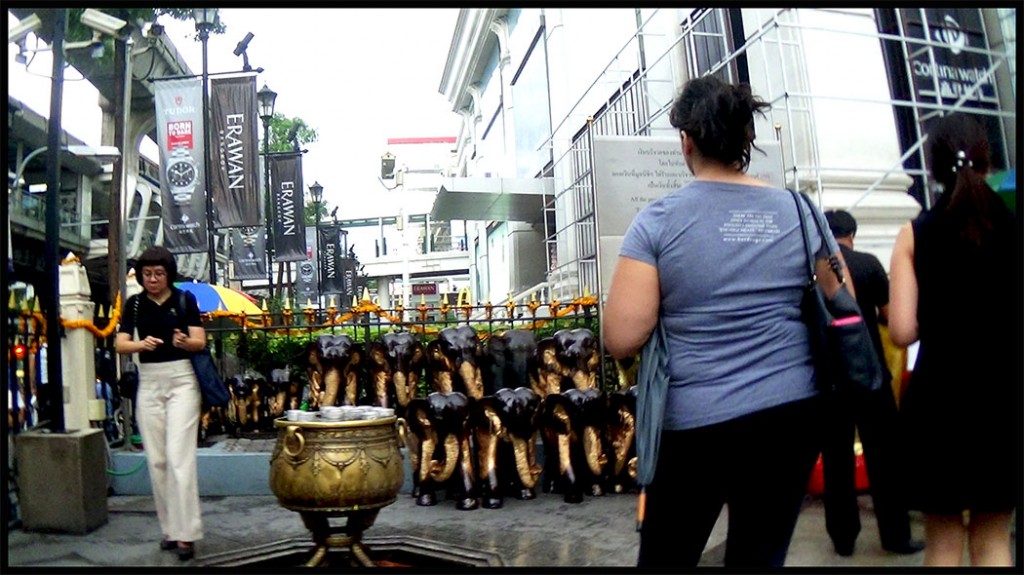 Elephant Statues used as adornment at the Worship of Phra Phrom (the four-faced Brahma God) at the Erawan Shrine, Bangkok, Thailand
Elephant Statues used as adornment at the Worship of Phra Phrom (the four-faced Brahma God) at the Erawan Shrine, Bangkok, Thailand
“The Earth is supported and guarded by mythical World Elephants at the compass points of the cardinal directions, according to the Hindu cosmology of ancient India. The classical Sanskrit literature also attributes earthquakes to the shaking of their bodies when they tire. Wisdom is represented by the elephant in the form of the deity Ganesh, one of the most popular gods in the Hindu religion‘s pantheon. Sometimes known as Ganesha, this deity is very distinctive in having a human form with the head of an elephant. This was put on after the human head was either was cut off or burned, depending on the version of the story from various Hindu sources. Lord Ganesha’s birthday (rebirth) is celebrated as the Hindu festival known as Ganesha Chaturthi.[4] In Japanese Buddhism, their adaptation of Ganesha is known as Kangiten (“Deva of Bliss”), often represented as an elephant-headed male and female pair shown in a standing embrace to represent unity of opposites.[5]”
For more information please visit the following link:
https://en.wikipedia.org/wiki/Cultural_depictions_of_elephants
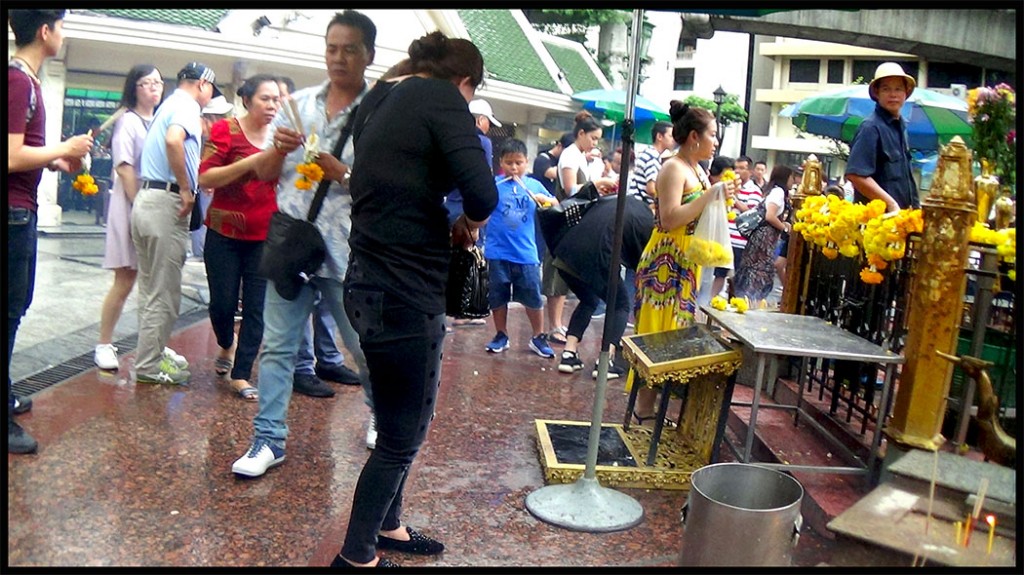
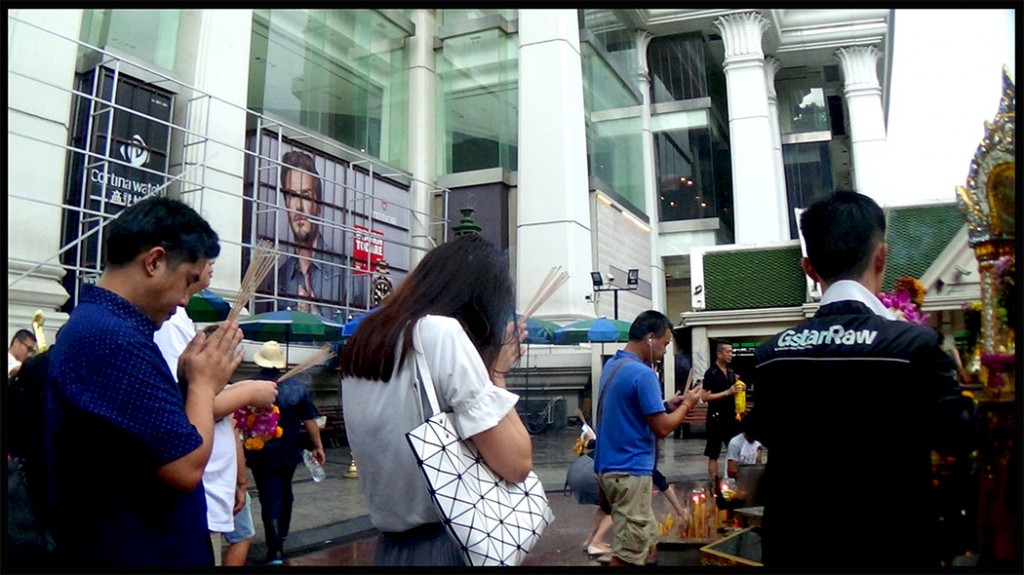
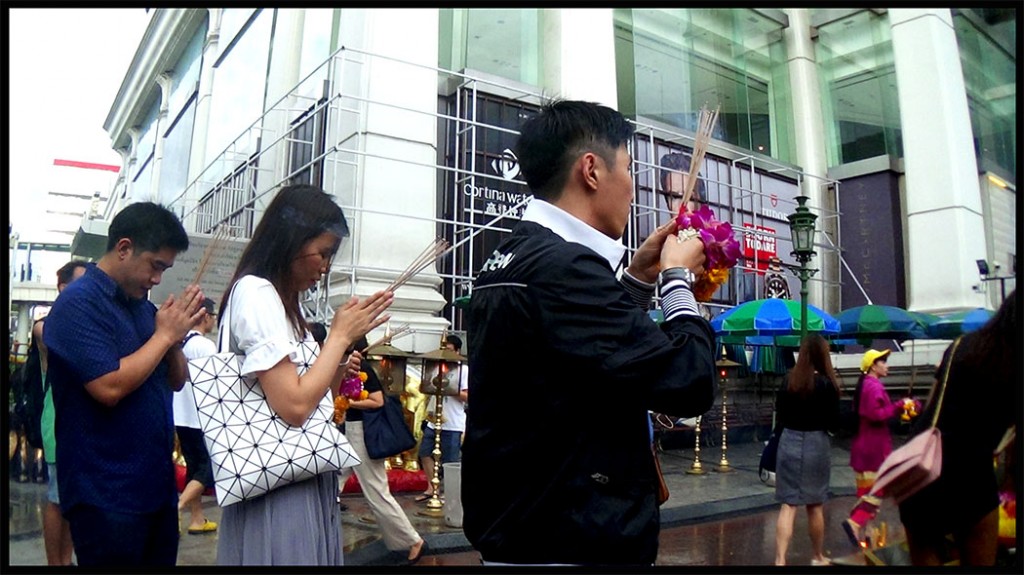
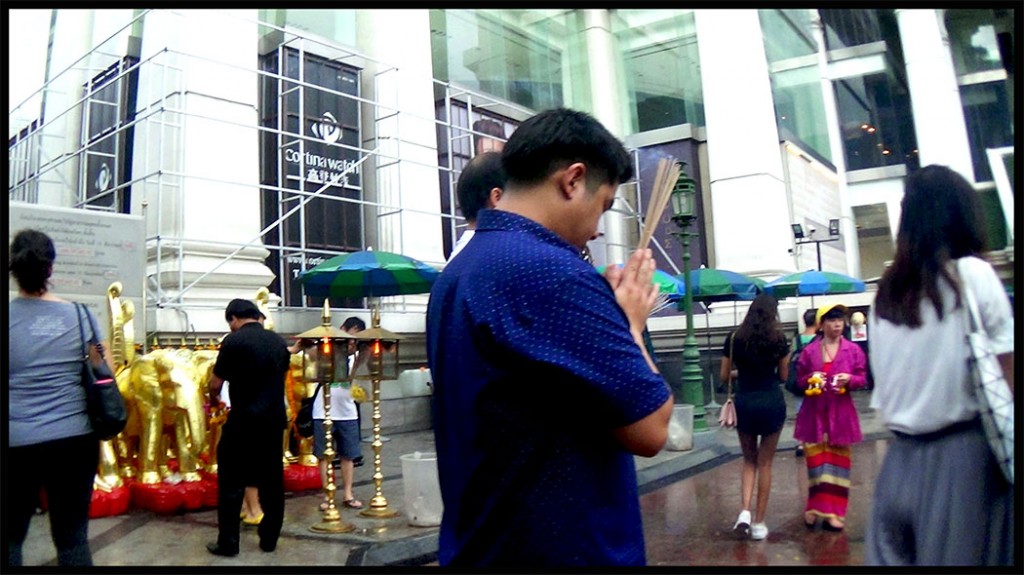
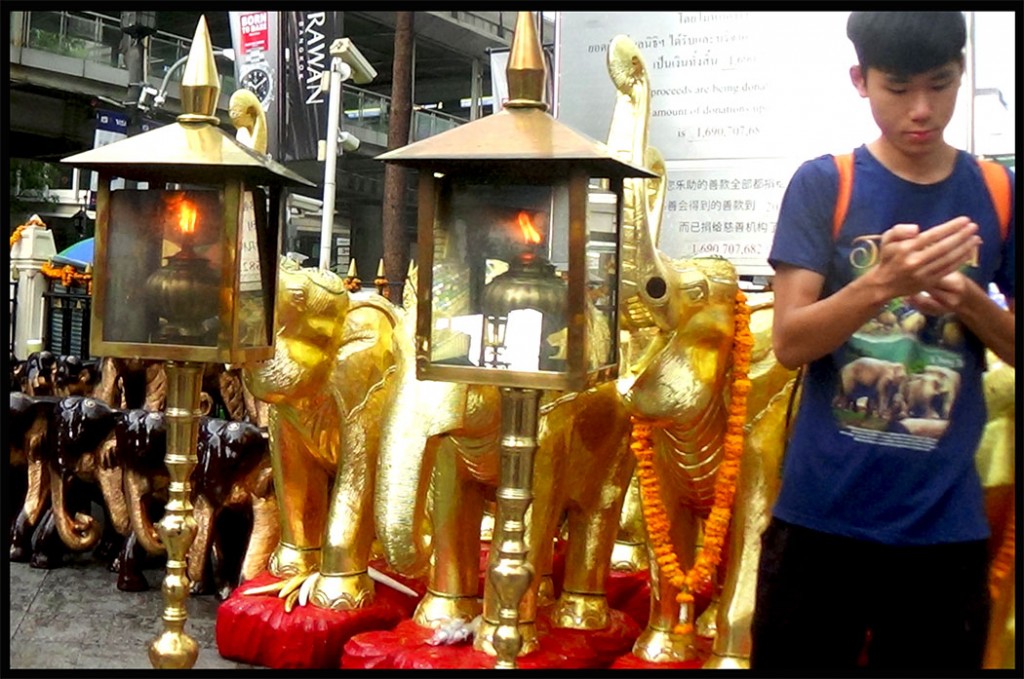 Elephant Statues used as adornment at the Worship of Phra Phrom (the four-faced Brahma God) at the Erawan Shrine, Bangkok, Thailand
Elephant Statues used as adornment at the Worship of Phra Phrom (the four-faced Brahma God) at the Erawan Shrine, Bangkok, Thailand
“In Hindu iconography, many devas are associated with a mount or vehicle known as a v?hana. In addition to providing a means of transport, they symbolically represent a divine attribute. The elephant v?hana represents wisdom, divine knowledge and royal power; it is associated with Lakshmi, Brihaspati, Shachi and Indra. Indra was said to ride on a flying white elephant named Airavata, who was made the King of all elephants by Lord Indra. A white elephant is rare and given special significance. It is often considered sacred and symbolises royalty in Thailand and Burma, where it is also considered a symbol of good luck. In Buddhist iconography, the elephant is associated with Queen M?y? of Sakya, the mother of Gautama Buddha. She had a vivid dream foretelling her pregnancy in which a white elephant featured prominently.[6] To the royal sages, the white elephant signifies royal majesty and authority; they interpreted the dream as meaning that her child was destined for greatness as a universal monarch or a buddha.[7]”
For more information please visit the following link:
https://en.wikipedia.org/wiki/Cultural_depictions_of_elephants
 Elephant Statues used as adornment at the Worship of Phra Phrom (the four-faced Brahma God) at the Erawan Shrine, Bangkok, Thailand
Elephant Statues used as adornment at the Worship of Phra Phrom (the four-faced Brahma God) at the Erawan Shrine, Bangkok, Thailand
“Elephants remain an integral part of religion in South Asia and some are even featured in various religious practices.[8] Temple elephants are specially trained captive elephants that are lavishly caparisoned and used in various temple activities. Among the most famous of the temple elephants is Guruvayur Keshavan of Kerala, India. They are also used in festivals in Sri Lanka such as the Esala Perahera.”
For more information please visit the following link:
https://en.wikipedia.org/wiki/Cultural_depictions_of_elephants
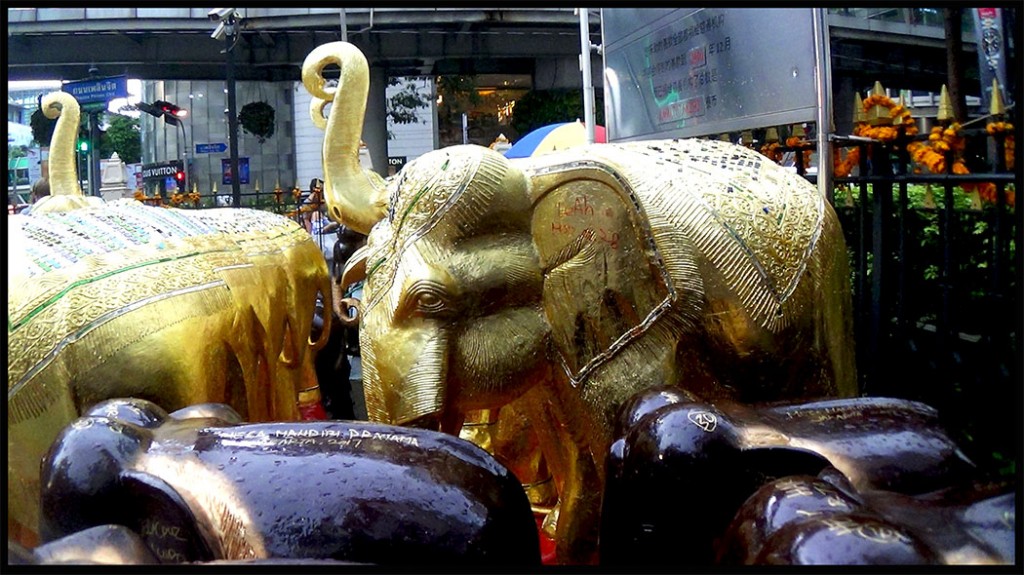 Elephant Statues used as adornment at the Worship of Phra Phrom (the four-faced Brahma God) at the Erawan Shrine, Bangkok, Thailand
Elephant Statues used as adornment at the Worship of Phra Phrom (the four-faced Brahma God) at the Erawan Shrine, Bangkok, Thailand
“In the version of the Chinese zodiac used in Northern Thailand, the last year in the 12-year cycle – called “Year of the Pig” in China – is known instead as “Year of the Elephant”, reflecting the importance of elephants in Thai culture.
In Islamic tradition, the year 570 is when the Prophet Muhammad was born and is known as the Year of the Elephant.[9] In that year, Abraha, ruler of Yemen tried to conquer Mecca and demolish the Kaaba, reportedly in retaliation for the previous Meccan defilement of Al–Qalis Church in Sana’a, a cathedral Abraha had constructed.[10] However, his plan was foiled when his white elephant named Mahmud refused to cross the boundary of Mecca. The elephant, who led Abraha’s forty thousand men, could not be persuaded with reason or even with violence, which was regarded as a crucial omen by Abraha’s soldiers. This is generally related in the five verses of the chapter titled ‘The Elephant‘[b] in the Quran.[11]”
For more information please visit the following link:
https://en.wikipedia.org/wiki/Cultural_depictions_of_elephants
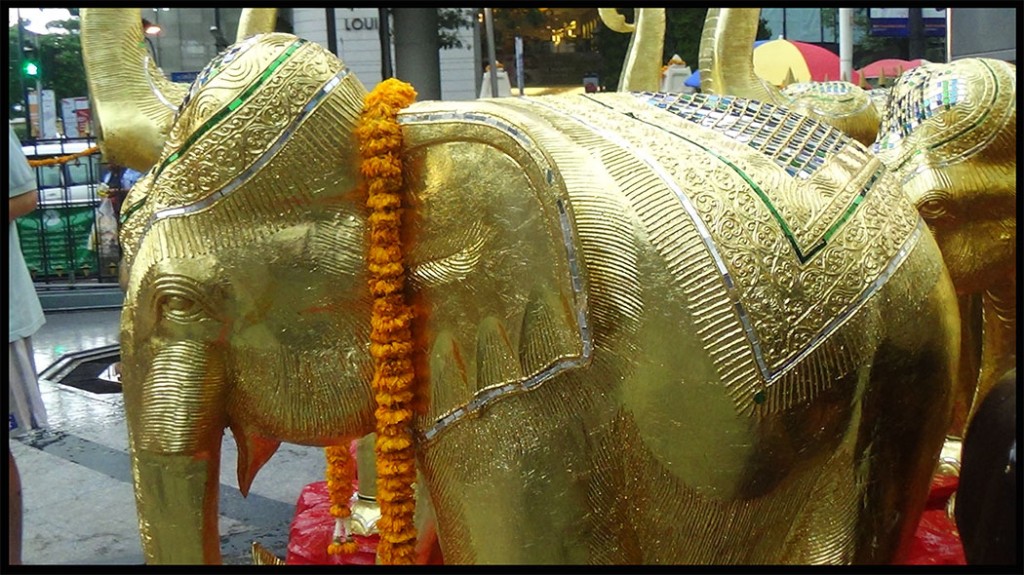 Elephant Statues used as adornment at the Worship of Phra Phrom (the four-faced Brahma God) at the Erawan Shrine, Bangkok, Thailand
Elephant Statues used as adornment at the Worship of Phra Phrom (the four-faced Brahma God) at the Erawan Shrine, Bangkok, Thailand
“In the Judeo-Christian tradition, medieval artists depicted the mutual killing of both Eleazar the Maccabee and a war elephant carrying an important Seleucid general as described in the apocryphal book of 1 Maccabees. The early illustrators knew little of the elephant and their portrayals are highly inaccurate.[12]
The unfamiliarity with the exotic beast has also made elephants a subject of widely different interpretations thus giving rise to mythological creatures. The story of the blind men and an elephant was written to show how reality may be viewed from differing perspectives. The source of this parable is unknown, but it appears to have originated in India. It has been attributed to Buddhists, Hindus, Jainists, and Sufis, and was also used by Discordians. The scattered skulls of prehistoric dwarf elephants, on the islands of Crete and Sicily may have formed the basis of belief in existence of cyclopes,[c] the one-eyed giants featured in Homer‘s Odyssey (c. 800~600 BC). As early as the 1370s, scholars had noted that the skulls feature a large nasal cavity at the front that could be mistaken for a singular eye socket;[13] and the skulls, twice the size of a human’s, looked as if they could belong to giant humanoids.[13][14] It is also suggested that the Behemoth described in the Book of Job may be the elephant due to its grazing habits and preference to rivers.[15]”
For more information please visit the following link:
https://en.wikipedia.org/wiki/Cultural_depictions_of_elephants
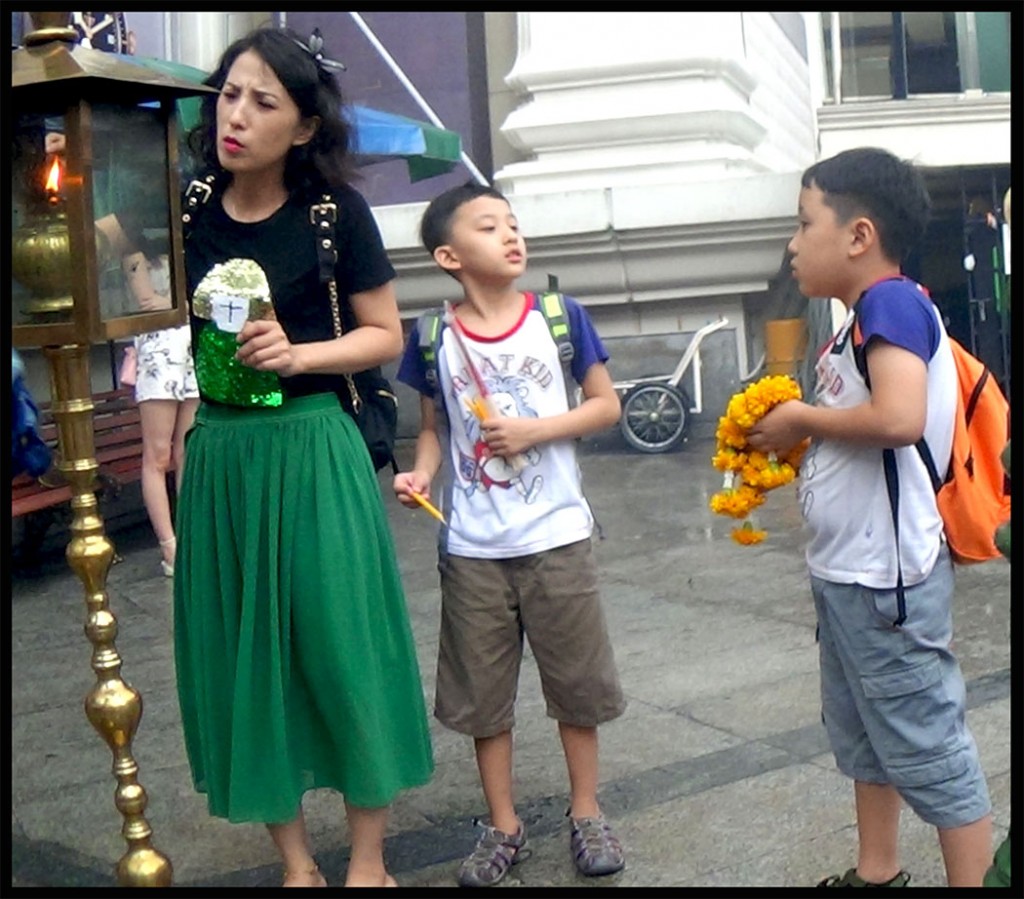
 The worshipers pay the dancers to dance for the Brahma God at the Erawan Shrine, Bangkok, Thailand
The worshipers pay the dancers to dance for the Brahma God at the Erawan Shrine, Bangkok, Thailand
Photograph by Ing-On Vibulbhan-Watts
“Than Tao Mahaprom is a Brahma god, full of kindness, mercy, sympathy and impartiality. These four virtues are represented by his four faces, each radiating serene grace. Since Buddhism in Thailand has always been influenced by the Brahma beliefs, he made an immediate impact. Nowadays, as has been the case for years, unending streams of people pay respects from early morning till late at night. Thais, and even foreign visitors, make ceremonial offerings from floral garlands, fruits to teakwood elephants in the hope that their wishes will be fulfilled. Judging from the flowing multitude of believers, for many those wishes were indeed granted. Cash contributions are managed by a foundation who distributes funds regularly to various charitable organisations and equipment for needy hospitals in the provinces. To feel the aura of reverence while watching the joyful celebration of a graceful Thai Classical Dance troupe or a lively Chinese Lion Dance is an experience to be added to your many memories of exotic Bangkok.”
For more information please visit the following link:
https://www.bangkok.com/shrines/erawan-shrine.htm#
RATE FOR DANCING
NUMBER OF DANCERS AMOUNT OF MONEY
8 710 BAHTS (ABOUT $24)
6 610 BAHTS (ABOUT $20)
4 360 BAHTS (ABOUT $12)
2 260 BAHTS (ABOUT $9.70)
How we are taught to believe:
This person just bought a small cage that keeps the life birds for sale. She is going to free the birds.
She is freeing the birds in a small cage. She probably prays or wish that her trouble will go away or wish for her good fortune. I just hope that the poor birds will not get trapped again to be in the same confinement from the poor low-income people who captured them. However, I am not sure, it might be a rich person who traps the birds and distributes them for sale to different locations for the believers to buy birds to free for their wishes or some kind of merit.
I probably would do the same if I were live in Thailand. People tend to do the same as other people in one’s own social believe, until someone points out and tells you to analyze the situation. Then you may see a different view point, or you may not. But staying outside of one own society for a period of time, one has a chance to look back, and allow yourself to think more about what we are taught to believe.
Ing-On Vibulbhan-Watts, Monday, November 13, 2017

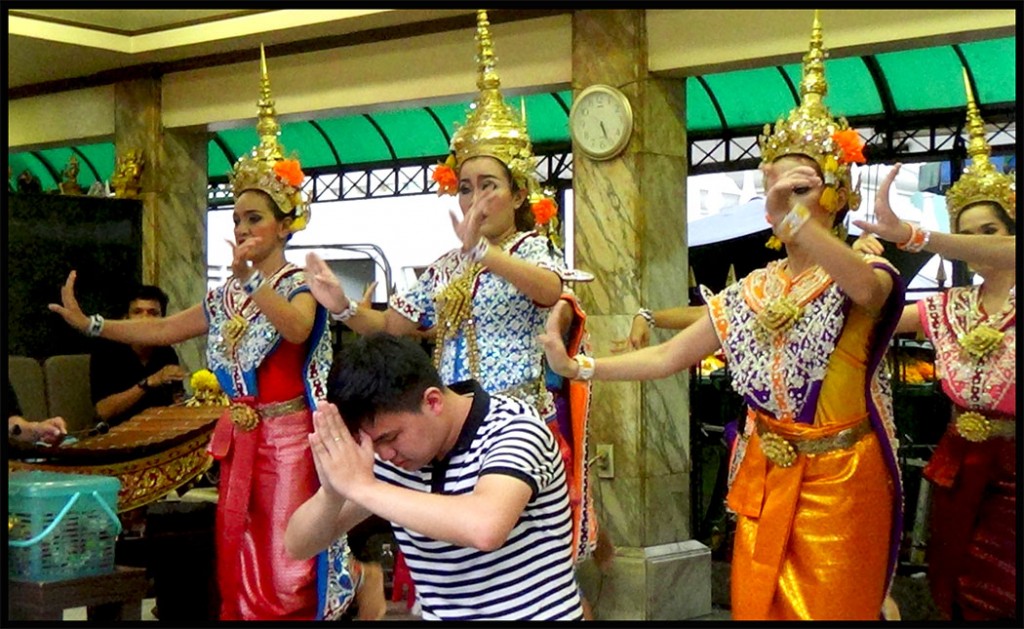
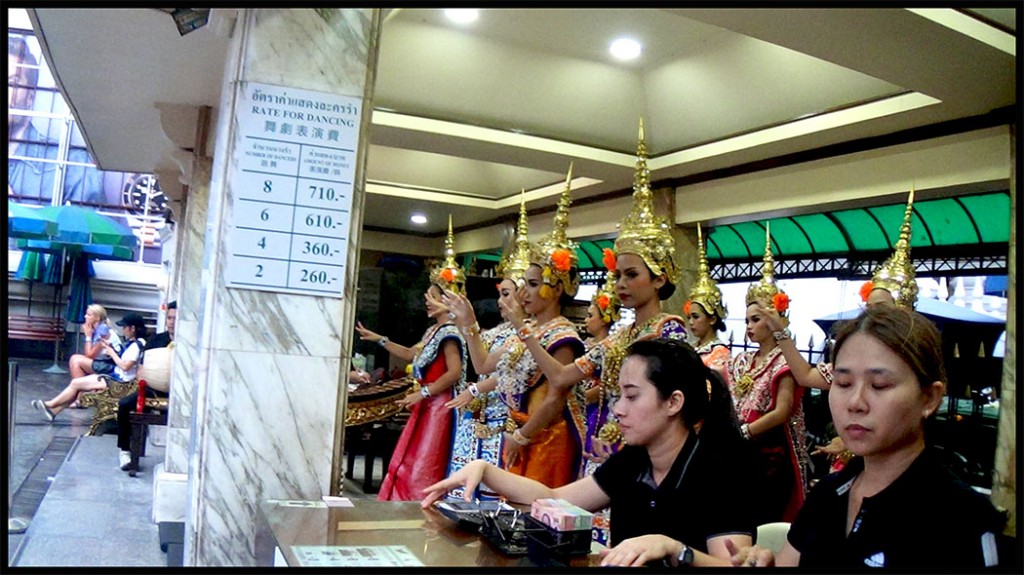
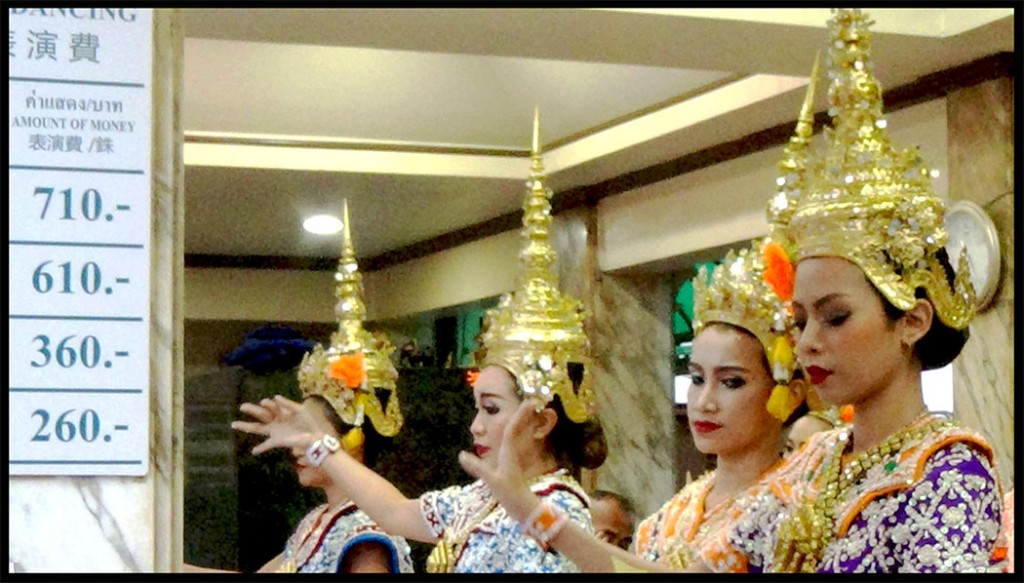


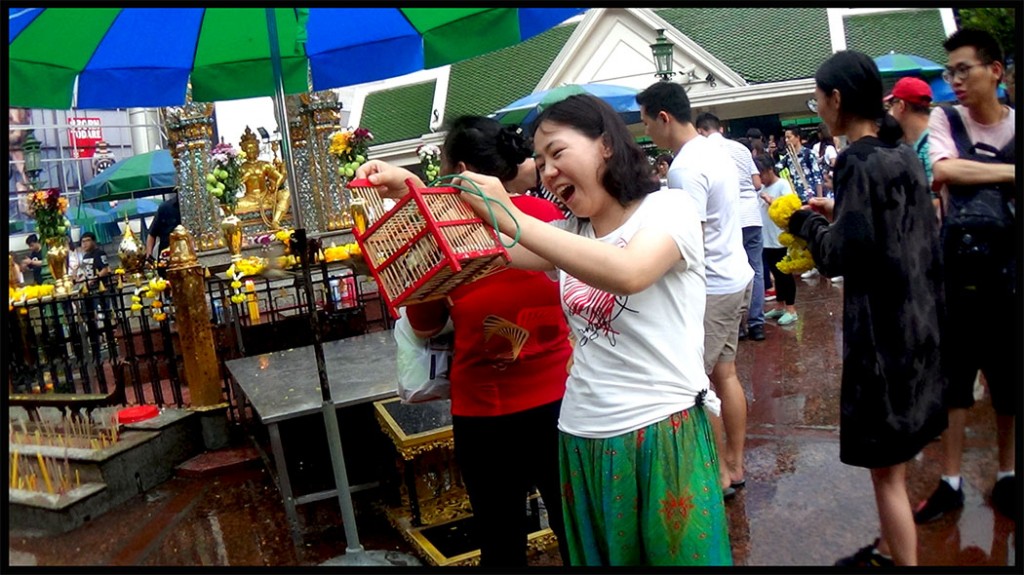
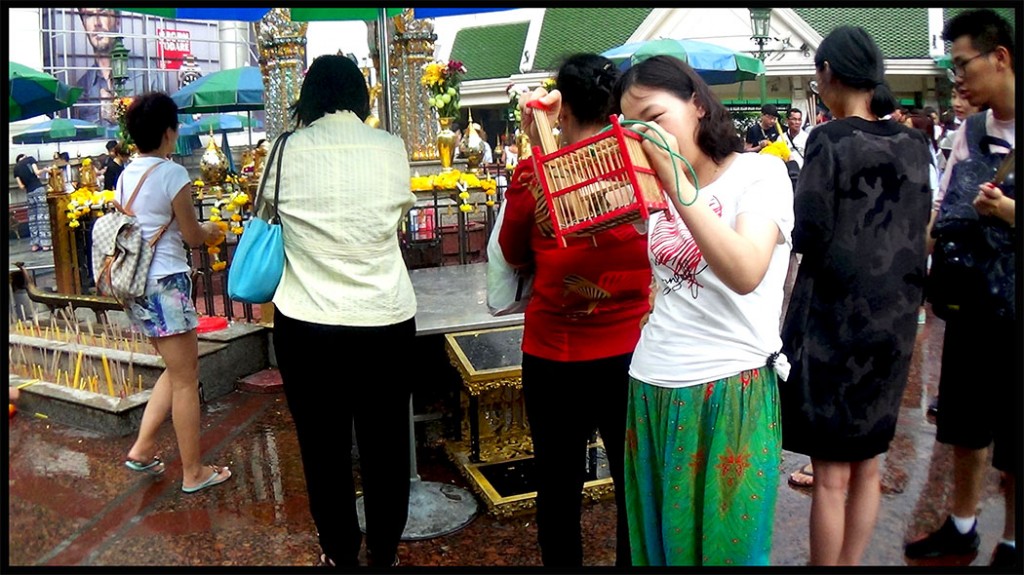
Leave a Reply